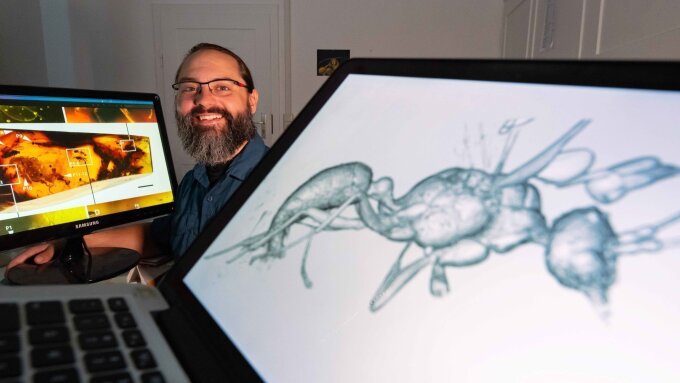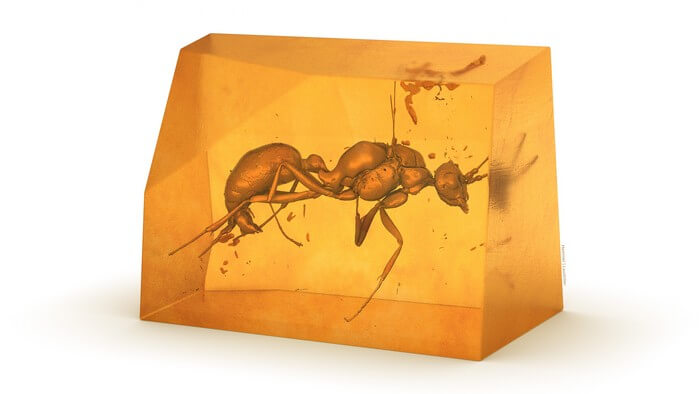A team of scientists from the Friedrich Schiller University in Jena, the University of Rennes in France, the University of Gdansk in Poland and the Helmholtz Center Hereon in Geesthacht have discovered a previously unknown extinct species of ant.
Using the PETRA III X-ray light source at the German Electron Synchrotron (DESY) in Hamburg, the team had examined the crucial fossil remains of 13 individual animals and realized that they could not be assigned to any known species. The new species and genus is named Desyopone hereongen. et sp. nov. The scientists are thus honoring the two research institutions involved, DESY and Hereon, who have made a significant contribution to this discovery with modern imaging methods. Ultimately, the identification of the new species and genus was only possible by combining extensive phenotype data from scans and more recent insights from genome analyzes of live ants. The team reports on its discovery in the research magazine “Insects”.
Ponerinae instead of Aneuretinae
Through initial anatomical comparisons, the scientists assumed that the animals in question were a species of the Aneuretinae, a nearly extinct subfamily of ants that is only known from fossils and from a living species from Sri Lanka. However, thanks to the high-resolution images obtained by synchrotron micro-computed tomography, they had to revise this thesis: ” The complex waist segment and the large but rudimentary mandibles, the mouthparts, are more familiar to us from the Ponerinae – i.e. the primordial ants, ” says Brendon Boudinot, who is currently working as part of a Humboldt research fellowship at the University of Jena. “We therefore assign the new species and genus to this subfamily, even if it has a previously unique shape, since the long waist and otherwise unconstricted abdomen are more reminiscent of the aneuretinae .”
The present research results also contribute to moving the male ants more into the focus of evolutionary research. “ Due to their body shape being so different from that of workers, research has neglected them for a long time. Because the fossil males are simply too often overlooked because they cannot be assigned correctly, ” says the ant expert. ” Our results not only update the literature on identifying male ants, but also show that by understanding male-specific traits, such as the sex-specific shape of the mandible, we can learn more about the evolutionary patterns of female ants.”.” Because in the present work, the researchers have identified a fundamental pattern that is found in all ants, namely that male and female mandibles follow the same developmental pattern in most species, even if they look very different.

Unique amber
Dating the find also presented the scientists with a number of challenges, as the amber itself is just as unique as its inner workings. “ The piece comes from the only amber deposit in Africa that has inclusions of fossil organisms. In general, there are only a few fossil insects from this continent. Although amber has long been used in jewelry by local people in the region, it has only been around a decade since researchers have discovered its scientific importance, ” explains Vincent Perrichot of the University of Rennes. “ The specimen therefore offers what is currently a unique insight into an ancient forest ecosystem in Africa.It dates from the early Miocene and is 16 to 23 million years old, according to the expert. Its complicated dating was only possible indirectly by determining the age of the fossil palynomorphs enclosed in the amber – i.e. the spores and pollen.
Modern methods for looking into the distant past
Research results like these are only possible through the use of the latest technology. Since the genetic material of fossils cannot be analysed, accurate data and observations of the animals’ morphology are particularly important. These can be obtained comprehensively using high-resolution imaging methods – such as micro-computed tomography (CT), in which the sample is literally illuminated with X-rays. ” Because the ants to be examined, enclosed in the amber, are very small and only show a very weak contrast in the classic CT, we carried out the CT at our measuring station, which specializes in such micro-tomography, ” explains Jörg Hammel from the Helmholtz Center Hereon. “In this way , the researchers received a stack of images that, in principle, depict the examined sample slice by slice .” Put together, these then resulted in detailed three-dimensional images of the internal structure of the animals, which they used to understand the anatomy exactly. This was the only way to identify the details that ultimately led to the determination of the new species and genus.
Original publication:
Brendon E. Boudinot, Adrian K. Richter, Jörg U. Hammel, Jacek Szwedo, Błażej Bojarski, Vincent Perrichot: “Genomic-phenomic reciprocal illumination: † Desyopone hereon gen. et sp. nov., an exceptional aneuretine-like fossil ant from Ethiopian amber (Hymenoptera: Formicidae: Ponerinae)”, Insects 2022 , 13 (9), 796; https://doi.org/10.3390/insects13090796

